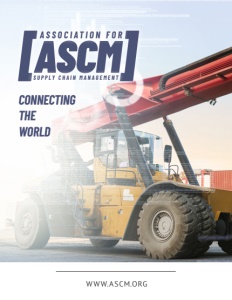Association for Supply Chain Management
Connecting the world
As supply chain slowdowns lessen, the Association for Supply Chain Management revs up for a productive member-focused agenda
Not that long ago, it was commonplace for cargo ships to be held back at harbors around the globe as the pandemic held its grip. Goods and supplies were routinely backlogged causing a ripple effect in every sector from construction through manufacturing. Time, fortunately, has helped to fix that.
With COVID in the rearview mirror, America’s supply chains have come roaring back. Though probably taken for granted by most people, supply chains are vitally important to everyone. They’re what get us everything that makes modern life possible, from grocery stores to gas stations to retail outlets.
An important organization playing a major role in the supply chain process is the Association for Supply Chain Management. ASCM is the global pacesetter of organizational transformation, talent development and supply chain innovation.
As the largest association for supply chains, the ASCM serves as an unbiased partner, connecting supply chain professionals and companies around the world to the newest thought leadership on all aspects of supply chains.
We recently spoke with the ASCM’s Chief Executive Officer, Abe Eshkenazi, CSCP,CPA, CAE. He told us more about the everyday importance of supply chains and his organization’s role in their vital work.
“I think the supply chain has become ubiquitous for almost everybody in the world today,” says Eshkenazi.
“Prior to the pandemic, I don’t know that there was a whole lot of understanding from consumers in terms of even the concept of supply chains. Obviously, the pandemic—with the resulting stock-outs and challenges we’ve had with products and services, from PPE’s (personal protective equipment) to paper—has really highlighted the criticality of having an efficient and effective supply chain for consumers.”
He explains that the foundations of a global supply chain include the sourcing of raw materials; the actual transformation of these raw materials into finished products; the delivery of course; and all aspects of the logistics involved: everything that’s encountered in providing a product from a raw material to assembly to a retail or an outlet for sale.
“I don’t know that people truly understand it,” Eshkenazi says. “Unfortunately, e-commerce has trained a lot of our consumers in terms of their understanding of supply chains. They ordered a product (over the Internet), and either it did or didn’t arrive. That’s the consumer’s understanding of supply chains.”
He also cites the indispensable and ever-present conveyors and conveyor belts. Everything we use or otherwise consume these days was at one point on a conveyor belt. Products may move untold thousands of miles before their buyers ever see them.
Yet as far as consumers understand, Eshkenazi notes, products are either on store shelves or they’re not. Since COVID, he adds, the global nature of these supply chains has presented real challenges for Tier II and Tier III vendors, usually small to medium-sized businesses that often support larger ones. Tariffs and other disruptions can also have huge impacts on supply chains.
“The pandemic really did expose a lot of the challenges within a global supply chain,” he adds.
“I think the expectations have not decreased but have increased, because of e-commerce.”
Everything from cars to major appliances may be ordered via the Internet these days. The logistics are a significant part of that system, says Eshkenazi. Unfortunately, warehousing and logistics are where most disruptions now occur. COVID-related demand shifts have occurred.
This has resulted in what he calls a bullwhip effect with excess inventories, and systems have yet to be re-balanced between supply and demand. Worse, data indicators are often unreliable, causing much stress for companies and consumers alike.
 Supply chain routes
Supply chain routes
“It’s a very interesting journey,” Eshkenazi observes, explaining ASCM’s origins and a scholarly study, completed in the 1950s, calling for greater recognition by consumers of the supply chains that served them, adding, “I think we need to note that the term ‘supply chain’ didn’t really come into our vernacular until the mid-’90’s. Most of it was operations management and industrial design. You had a variety of different terms for it that really did not adequately represent the true supply chain.”
He continues that the advent of computer technology, beginning with its earliest stages and IBM in the 1950s and ’60s, provided an opportunity for a recognition of the role and responsibility that supply chain professionals or operations management professionals had.
The focus was on establishing a body of knowledge. Secondly came a recognition of what ops managers did, regarding the supply chains within their organizations. It’s just that it took more than half a century for such matters to be properly appreciated, as Eshkenazi notes.
“Unfortunately,” he adds, “it took a pandemic for people to really to take notice Dialing the clock back, the mission was focused on the individual: developing confident and capable employees that can understand what the production schedules are and what inventory requirements are.
“We, as an organization, embrace not only the individual and prepare them through our certifications, competencies, content, education, and professional development focus,” he continues, “but also the corporation, ensuring that they’re recognizing the individuals and rewarding them for the contributions they make; and more importantly, ensuring that they have individuals who understand the role that supply chains play within their organizations. We embrace that responsibility that we can represent the individual, but we also need to make sure we represent the organization and ensure that companies can develop sustainable supply chains.”
The focus there, as Eshkenazi points out, is on ethical, economic, and environmentally sustainable business practices.. This was accomplished through mergers with other supply chain councils, thus forming a focus on the company.
“We realized that our responsibility was first to the individual, preparing them and ensuring that they are competent and capable,” he says, “and I think we need to understand that prior to 2000, there were only about a dozen schools in the world that had a supply chain academic program, either a baccalaureate or a masters.”
“So our certification, our CPIM—certified planning inventory management—was a replacement for the baccalaureate degree, because these individuals needed to be recognized, and certification was one of the ways to do so. Our development of the certification really did enhance the role and the responsibility for these individuals, and more importantly, it assured that the company, when they were hiring, can be sure that this individual was a subject-matter expert in planning and inventory management.”
It was this, says Eshkenazi, that laid the foundations for ASCM’s certifications that have since become the industry standards.
The mission’s emphasis was always on the individual. It also now includes the ASCM itself, in order to ensure that it can represent supply chains to consumers and to the investment community appropriately.
Organizations that focus on sustainable supply chains are much more successful, he adds.
“We have embraced the responsibility not only for the individual but also for the company to ensure that they are effective, efficient, and ethical in terms of their business practices,” he further explains.
“We believe that we can make a better world through supply chain and that is through having competent individuals with organizations that understand sustainable supply chains are a winning formula.”
 Global focus
Global focus
Today, the ASCM is comprised of some 45,000 members around the globe. A significant portion, as you might expect, comes of course from the United States. Significant numbers elsewhere come from the European business world and developing nations. Eshkenazi reveals that ASCM membership has grown by some 10 percent just from the beginning of last year alone. That was when the group launched updated memberships available for just $99 per year..
“Individuals can add on to their memberships for additional fees, for certifications or belonging to a chapter,” he says, “which gives them some mentoring or related opportunities to engage with other supply chain professionals.”
“Currently, we don’t have an affiliate membership, because most of these individuals are in a supply chain function, so they identify themselves as supply chain professionals. There are a variety of jobs within supply chains. There is no job called supply chain,” he elaborates.
“I think that’s one of the first things individuals need to understand. A lot like engineering, there’s no job called ‘engineer.’ There’s civil, there’s [the title] architect; there is a variety of engineers. Similarly, with supply chains, there is no job called ‘supply chain,’ but there are a variety of jobs within planning, within warehousing, sustainability, and within a variety of different roles that are supply chain functions.”
The focus, he adds, is to prepare people, irrespective of where they are in their careers. From entry-level to mid-career to leadership, there are many opportunities.”
A resource center provides content for people, depending on their roles, responsibility, and levels of experience. It also provides them with opportunities for community engagement, whether Internet-based or in-person. Through ASCM membership, there are mentorial work, career assistance, and job fairs.
“We are very fortunate,” Eshkenazi observes, “to have some extremely dedicated volunteers that guide our organization.”
AT A GLANCE
Association for Supply Chain Management
What: The global pacesetter of organizational transformation, talent development and supply chain innovation.
Where: headquartered in Chicago
Website: www.ascm.org


